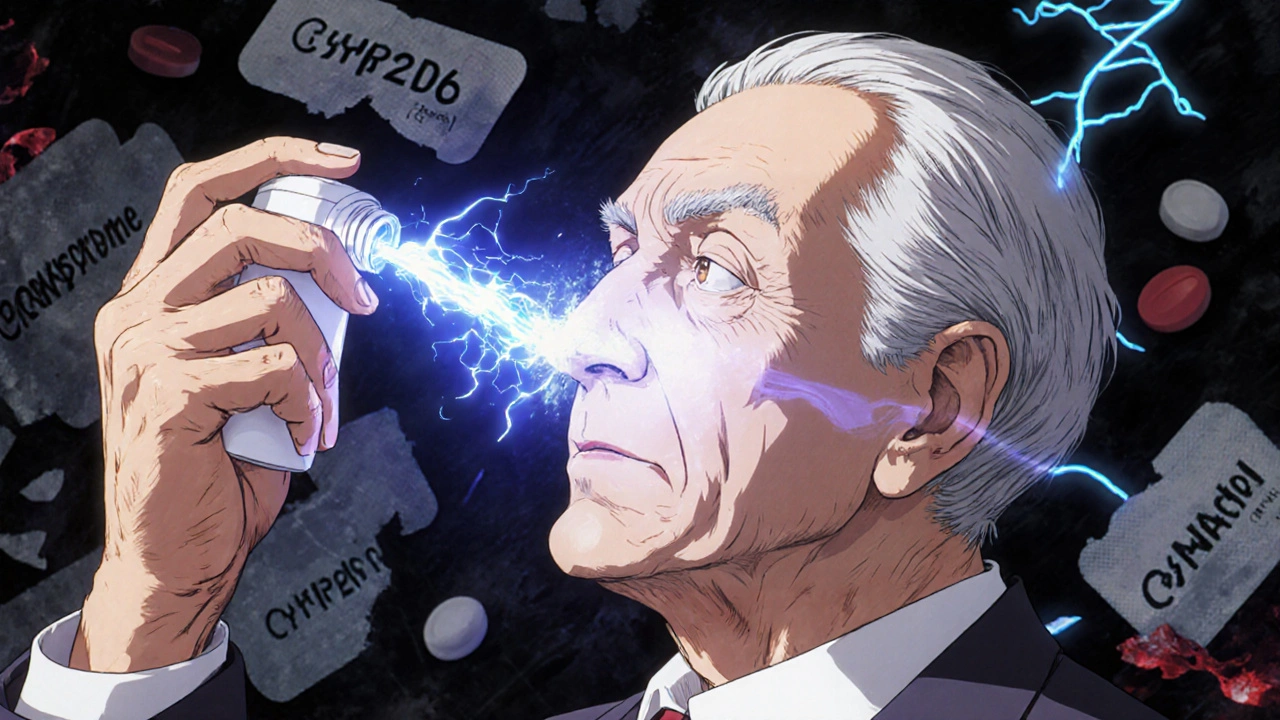
Nausea Risk Assessment Tool
This tool helps you understand your risk for medication-induced nausea (especially after surgery) using the evidence-based Apfel Score system. The Apfel Score is used by doctors to determine the best antiemetic treatment for your individual situation.
Your Apfel Score:
What this means:
When you're recovering from surgery, starting a new painkiller, or going through chemotherapy, nausea isn't just annoying-it can delay healing, make you feel helpless, and even keep you in the hospital longer. Medication-induced nausea is one of the most common side effects people face, and it’s not something you just have to live with. There are effective, safe options-but choosing the right one isn’t simple. Pick the wrong drug, and you could end up with worse side effects than the nausea itself. This isn’t about guessing. It’s about matching the right antiemetic to your situation, your risk level, and your body’s response.
What Exactly Are Antiemetics?
Antiemetics are drugs designed to stop nausea and vomiting. They don’t treat the cause-they block the signals in your brain and gut that trigger those feelings. There are seven main types, each working differently. Some target serotonin receptors (like ondansetron), others block dopamine (like droperidol), and some, like dexamethasone, work through multiple pathways. The key is knowing which type works best for your specific cause of nausea.
For example, if you’re nauseous after surgery (postoperative nausea and vomiting, or PONV), serotonin blockers like ondansetron are often the first choice. But if you’re on opioids for pain, dopamine blockers like droperidol might work better. And if you’re getting chemotherapy, you’ll likely need a combo of drugs, not just one.
Top Antiemetics Used Today-and How They Compare
Not all antiemetics are created equal. Here’s what actually works based on real clinical data:
- Ondansetron (Zofran): Blocks serotonin. Standard dose: 4-8 mg IV. Works in 15-30 minutes. Efficacy: 65-75% in preventing PONV. Side effects: headache (32% of users), dizziness. Cost: $1.25 per 4 mg dose.
- Droperidol (Inapsine): Blocks dopamine. Low dose: 0.625-1.25 mg IV. Efficacy: 12-14.5% PONV rate vs. 21% placebo. Works faster than ondansetron in opioid-tolerant patients. Side effects: rare but serious QT prolongation. Cost: $0.50 per dose.
- Dexamethasone: A steroid. Dose: 8 mg IV. Takes 4-5 hours to kick in. Doesn’t work alone well-but adds 20-30% more protection when paired with ondansetron or droperidol. Cost: $0.25 per dose.
- Metoclopramide (Reglan): Dopamine blocker + speeds up stomach emptying. Dose: 25-50 mg IV works best. 10 mg is often too weak. Side effects: akathisia (restlessness) in up to 8% of elderly patients. Not ideal for pure medication-induced nausea.
- Promethazine: Antihistamine. Dose: 25 mg IV. Works okay for motion sickness, but weak for surgery or chemo nausea. Risk: tissue damage if leaked outside vein.
Here’s a quick comparison of key drugs for PONV:
| Drug | Dose | Efficacy (PONV Reduction) | Onset | Cost per Dose | Key Risk |
|---|---|---|---|---|---|
| Ondansetron | 4-8 mg IV | 65-75% | 15-30 min | $1.25 | Headache, dizziness, QT prolongation (rare) |
| Droperidol | 0.625-1.25 mg IV | 67-86% | 10-20 min | $0.50 | QT prolongation (doses >1.25 mg) |
| Dexamethasone | 8 mg IV | 20-30% (as add-on) | 4-5 hours | $0.25 | High blood sugar, insomnia |
| Metoclopramide | 25-50 mg IV | 44-68% | 20-40 min | $0.80 | Akathisia (especially in elderly) |
Drop the idea that "stronger" means better. Droperidol at 0.625 mg is just as effective as 4 mg of ondansetron in many cases-and costs half as much. And dexamethasone, though slow, is a powerhouse when combined with either.
How to Pick the Right One: The Apfel Score
Doctors don’t guess. They use a tool called the Apfel score. It’s simple: four risk factors.
- Female sex
- Non-smoker
- History of motion sickness or past PONV
- Will get opioids after surgery
Count how many you have:
- 0-1 risk factors: No preventive antiemetic needed. Only treat if nausea hits.
- 2 risk factors: One drug. Ondansetron 4 mg or droperidol 0.625 mg.
- 3-4 risk factors: Two drugs. Droperidol 0.625 mg + dexamethasone 8 mg.
This isn’t theory. A 2023 study of over 20,000 patients showed using this approach cut unnecessary antiemetic use by 40% and reduced PONV by half. It’s the difference between giving drugs to everyone and giving them only to those who need them.

What Doesn’t Work-And Why
Some drugs get used out of habit, not evidence.
Promethazine? It’s been around since the 1940s. It helps with motion sickness, but for surgery or chemo nausea? It’s weak. And if it leaks into the tissue during injection, it can cause serious damage.
Scopolamine patches? Great for motion sickness, but they take 4 hours to work. Useless if you’re already nauseous after surgery.
Metoclopramide at 10 mg? That’s a common mistake. Studies show 10 mg barely works. You need 25-50 mg. But even then, it causes restlessness-especially in older adults. Many hospitals have switched to olanzapine for elderly patients because it’s more reliable and safer.
And don’t assume newer = better. Netupitant/palonosetron (Akynzeo) costs $350 a dose. Ondansetron costs $1.25. For most people, the cheaper drug works just as well.
Safety First: The Hidden Risks
Every antiemetic has trade-offs.
Ondansetron can prolong the QT interval on an ECG. That’s not a problem for healthy people-but if you have heart disease, low potassium, or take other QT-prolonging drugs, it’s dangerous. The FDA has black box warnings for dolasetron and ondansetron in high-risk patients.
Droperidol has the same QT risk-but only at doses above 1.25 mg. At the low doses used for PONV (0.625 mg), it’s one of the safest options. Still, some hospitals avoid it out of fear. That’s a mistake. The data supports its safety at low doses.
Dexamethasone can raise blood sugar. If you’re diabetic, your dose may need adjusting. It can also cause insomnia or mood changes.
Metoclopramide can cause involuntary muscle movements-akathisia-if used too long or at too high a dose. That’s why it’s rarely used beyond a few days.
The bottom line: Don’t just pick the drug with the highest efficacy. Pick the one with the best safety profile for you.

Real-World Insights from Clinicians
What do doctors actually do in the real world?
At Massachusetts General Hospital, anesthesiologists started combining dexamethasone 4 mg with ondansetron 4 mg for opioid-induced nausea. Result? Rescue meds dropped by 32%. That’s huge.
On Reddit, anesthesiologists say droperidol 0.625 mg beats ondansetron in opioid-tolerant patients. Why? Because it works on dopamine, which opioids stimulate. Ondansetron doesn’t touch that pathway.
One ER doctor on Medscape reported 8% of elderly patients got severe restlessness from metoclopramide 10 mg. Now they use olanzapine 2.5-5 mg instead. It’s not FDA-approved for PONV, but real-world results are better.
Cost matters too. A 2023 IQVIA report found that hospitals with antiemetic stewardship programs saved 15-25% by switching to generics and using the Apfel score. That’s not just money-it’s better care.
What’s New in 2025
There are updates worth knowing.
Intranasal ondansetron (Zuplenz) got FDA approval in 2024. It’s great for people who can’t swallow pills or have IV access issues. Bioavailability is 89%-almost as good as IV.
For chemotherapy, NK-1 receptor antagonists like rolapitant are now used for delayed nausea (days after chemo). They’re not for surgery, but they’re changing cancer care.
And research is starting to look at genetics. Some people metabolize ondansetron faster because of their CYP2D6 gene. That means they need higher doses. Personalized antiemetics might be the future.
But for now, the best tool is still simple: know your risk, match the drug to the cause, and avoid overtreating.
Bottom Line: Your Action Plan
If you’re facing medication-induced nausea, here’s what to do:
- Ask: What’s causing the nausea? Surgery? Opioids? Chemo?
- Know your risk: Are you female? A non-smoker? Had nausea before? Will get opioids?
- Don’t assume the newest or most expensive drug is best. Ondansetron, droperidol, and dexamethasone cover 90% of cases.
- For low risk: Wait and treat if needed.
- For moderate risk: One drug-droperidol 0.625 mg or ondansetron 4 mg.
- For high risk: Two drugs-droperidol + dexamethasone.
- Avoid metoclopramide 10 mg. If you need it, use 25-50 mg.
- Watch for side effects: headache, dizziness, restlessness, or heart rhythm changes.
Medication-induced nausea is treatable. But it’s not a one-size-fits-all problem. The safest choice isn’t always the most popular one. It’s the one that fits your body, your risk, and your situation.

King Over
November 20, 2025 AT 20:20Been through chemo and surgery back to back. Ondansetron did jack for me. Droperidol at 0.625 mg? Game changer. No headache, no dizziness. Just quiet. Cost? Barely a cup of coffee.
Johannah Lavin
November 22, 2025 AT 00:11OMG YES 😭 I had PONV after my knee surgery and they gave me promethazine... and it leaked? Like, into my vein? I thought I was gonna lose my arm 🤢 Thank you for calling out how dangerous that is. Dexamethasone + droperidol? I’m telling my surgeon tomorrow. This post saved me from another nightmare.
Ravinder Singh
November 23, 2025 AT 05:49As someone from India where generic meds are the norm, I’m thrilled to see real data on cost-effectiveness. Ondansetron at $1.25 vs Akynzeo at $350? The math isn’t even close. But what’s more impressive is how the Apfel score reduces unnecessary prescriptions. In our hospital, we’ve cut antiemetic waste by 35% since adopting it. It’s not just about saving money-it’s about respecting patient autonomy. Don’t treat everyone like they’re at high risk. Let the numbers guide you. Also, metoclopramide at 10 mg? That’s like giving a Band-Aid for a broken leg. 25 mg minimum. And even then, watch for akathisia-especially in elders. Olanzapine is quietly becoming the unsung hero here.
Russ Bergeman
November 24, 2025 AT 14:45Wait-so you’re saying droperidol is safe at 0.625mg? But the FDA black box says QT prolongation!!?? And you’re just… ignoring that? I mean, come on. This is reckless. Ondansetron is the gold standard. Everyone knows that. Why are you pushing a drug that’s been pulled from markets in Europe? Also, dexamethasone? For nausea? That’s like using a flamethrower to light a candle. And why no mention of aprepitant? You’re clearly not a real clinician.
Dana Oralkhan
November 25, 2025 AT 08:05This is so helpful. I’m a nurse and I’ve seen so many patients get the wrong drug because it’s ‘what we’ve always done.’ I love how you broke down the Apfel score-it’s so simple, yet so powerful. I’m printing this out for our unit. And thank you for calling out promethazine. I’ve seen so many near-misses with extravasation. We need more posts like this. Real, practical, no fluff.